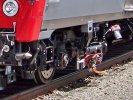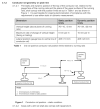JohnElliott
Member
- Joined
- 15 Sep 2014
- Messages
- 231
The pickup shoes would extend outside the current loading gauge, so instead of rebuilding all the overbridges on a route to make space for wires you'd be rebuilding all the underbridge parapets and platforms (and point motors?) to make space for the shoes.Do UK clearances make bottom contact third rail impossible?
And if you were going to introduce a new system not compatible with anything currently running that needs thorough rebuilding of lineside structures, you might as well go for overhead DC rather than ankle-height DC.


